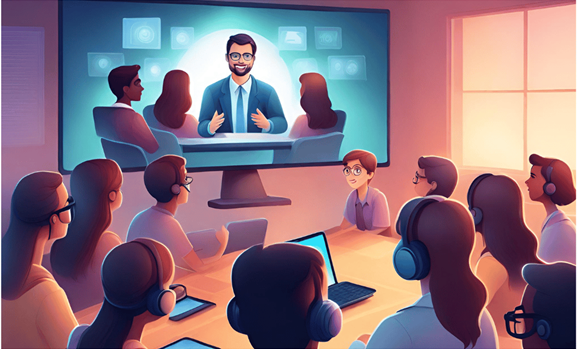
7 Key Benefits of Video Conferencing in Healthcare Sector
In our daily courses of life, we humans have lots of tasks to perform and achieve. An essential factor, to keep us going on and achieve these is our well-being and good health. Staying and being healthy is very necessary because of the direct impact it can have on ourselves and our routines, which the recent COVID-19 would’ve taught us. But wait, where’s the time in this busy world? Well, why worry when you have the technology of video conferencing right at your fingertips?
Video conferencing is a component of the overall telemedicine concept that facilitates the development of patient relationships while streamlining medical practice. This technology, together with other telehealth technologies such as chats, video, and phone conversations, enables virtual environments for remote patient diagnostics, monitoring, and treatment.
Video conferencing is especially crucial for people who need constant monitoring and control, such as high-risk patients suffering from chronic conditions. Taking into account the time spent getting to the hospital and the hours spent waiting for an appointment, this method is game-changing for patients. So it’s no wonder that the market is predicted to be worth about $800 million by 2026.
Keep reading as we discuss more about the importance and role of video conferencing in the healthcare sector.
Impact of Video Conferencing in Healthcare
During COVID-19, doctors and healthcare workers were in a higher danger when assessing sick patients. One of the most effective techniques to prevent and reduce transmission was to keep distance or quarantine in isolation. That is when Video Conferencing Solutions come into play.
Video conferencing fundamentally altered the nature of how we communicate. Coronavirus patients were reportedly placed in quarantine without first informing their relatives. During such difficult times, Video Conferencing Calls enabled sufferers to maintain contact with their loved ones.

Let’s understand the impact of video conferencing technology on the healthcare sector in more detail:
1. Improved Access to Care
Video conferencing has significantly improved access to healthcare, especially in underserved and remote areas. According to a recent study, the global telehealth industry was worth USD 101.2 billion in 2023 and is expected to grow at a compound annual growth rate (CAGR) of 24.3% between 2024 and 2030. The market is expanding majorly because of the COVID-19 epidemic, which has increased the need for virtual consultations and remote monitoring.
2. Cost Savings
The implementation of video conferencing in healthcare has resulted in substantial cost savings for both patients and healthcare providers. Patients can avoid the expenses associated with travel, such as transportation costs and lost productivity due to time off work. Healthcare providers also benefit from reduced overhead costs and increased efficiency, as virtual consultations eliminate the need for dedicated physical spaces and minimize the time spent commuting between locations.
3. Improved Patient Outcomes
Video conferencing has facilitated timely interventions and enhanced care coordination, ultimately leading to improved patient outcomes. Through virtual consultations, healthcare professionals can promptly assess and triage patients, ensuring they receive appropriate care promptly. Additionally, video conferencing enables seamless collaboration among multidisciplinary teams, allowing for comprehensive treatment planning and leveraging the collective expertise of various specialists.
4. Increased Patient Satisfaction
Patients have reported high levels of satisfaction with the convenience and accessibility offered by video conferencing in healthcare. The ability to receive care from the comfort of their own homes or familiar settings, without the burden of travel, has contributed to a positive patient experience. Furthermore, the increased access to healthcare services has fostered a sense of empowerment and engagement among patients, enhancing their overall satisfaction with the care they receive.
7 Benefits of Video Conferencing in Healthcare
Healthcare providers can offer video help to patients who have major chronic conditions and require continual monitoring. Instead of requiring these old or infirm individuals to travel to a doctor’s office, video conferencing enables the easy exchange of information between a professional team and their patient, all from the comfort of their own homes.

Here are a few more benefits of video conferencing in healthcare:
1. Healthcare Providers Can Reach out to More People
Through video conferencing, you can extend your services to remote areas or patients who have mobility issues. This technology bridges the geographical gap, allowing you to provide medical consultations and care to a wider population. For instance, telemedicine initiatives have been instrumental in reaching underserved communities and ensuring equitable access to healthcare.
2. Saves Time & Money
Video consultations eliminate the need for travel, reducing both time and cost for patients and healthcare providers. This convenience is especially valuable for follow-up appointments, routine check-ups, or chronic condition management, where physical presence may not be necessary. By minimizing travel expenses and lost productivity due to commuting, video conferencing offers significant cost savings.
3. Able to Handle Emergencies Easily
In critical situations, timely intervention can be life-saving. Video conferencing enables you to quickly assess and triage patients in remote locations, providing immediate guidance until physical transportation is arranged. This capability is particularly valuable in rural areas or during natural disasters when immediate on-site medical assistance may not be readily available.
4. Allows Doctors to Give Consultation Easily
With video conferencing, you can seamlessly provide consultations to patients from the convenience of your office or facility. This flexibility enhances accessibility and ensures continuity of care, especially for patients with limited mobility or those residing in remote areas. Additionally, it facilitates second opinions from specialists without the need for physical travel, expediting the diagnostic and treatment process.
5. Better Professional Collaboration
Video conferencing fosters collaboration among healthcare professionals across different locations. Multidisciplinary teams can convene virtually, discuss complex cases, and devise comprehensive treatment plans. This collaborative approach ensures that patients receive the collective expertise of various specialists, leading to improved patient outcomes.
6. VC Provides a Secure Virtual Environment
Reputable video conferencing platforms prioritize data security and privacy, adhering to stringent healthcare regulations. By implementing robust encryption and access controls, you can conduct virtual consultations and share sensitive medical information with confidence, knowing that patient confidentiality is maintained.
7. Able to Give Advance Medical Training
Video conferencing revolutionizes medical education and training. You can participate in virtual workshops, seminars, or even simulated procedures, leveraging the expertise of renowned instructors from around the globe. This accessibility to advanced training opportunities enhances professional development and facilitates the dissemination of cutting-edge medical knowledge and techniques.
Conclusion
In healthcare, video conferencing cannot completely replace in-person doctor appointments. However, this digital solution is ideal for a variety of situations, including regular check-ins, patients in faraway areas, preventive consultations, and many more. Implementing video conferencing software has several advantages, including improved appointment scheduling, reduced patient no-shows, medical training, reporting, and streamlined healthcare processes. As a result, people receive high-quality medical care, while providers earn well-deserved revenue.




